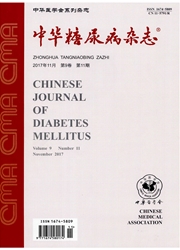

 中文摘要:
中文摘要:
目的探讨内吗啡肽(EMs)对糖基化终末产物(AGEs)培养条件下人脐静脉内皮细胞(HUVEC)合成分泌一氧化氮(NO)、内皮型一氧化氮合酶(eNOS)、内皮素1(ET-1)的影响。方法体外制备AGEs修饰的牛血清白蛋白(AGEs—BSA);分别用AGEs—BSA、EMs(1×10-5、1×10-6、1×10-7、1×10-8mol/LEM1或EM2)+AGEs—BSA及EMs(1×10-5mol/LEMl或EM2)+纳洛酮+AGEs.BSA共同干预HUVEC,同时以只加BSA的HUVEC作为阴性对照。噻唑蓝(MTT)法检测各组HUVEC存活率;放射免疫法检测各组NO、eNOS水平;酶联免疫吸附实验(ELISA)法测定各组ET-1表达量;实时荧光定量聚合酶链反应(RT—PCR)法检测各组eNOS、ET-1mRNA的表达。采用单因素方差分析及t检验进行数据统计。结果与AGEs—BSA组相比,1×10-5mol/LEM1干预组HUVEC存活率增加,NO分泌量减少[分别为0.89±0.05VS0.67±0.02和(14.8±1.4)VS(23.0±0.7)μmol/L,t值分别为9.86、13.18,均P〈0.05],ET-1产生及其mRNA表达降低[分别为(0.85±0.01)VS(0.99±0.01)μg/L和10.6±0.7VS25.6±1.6,t值分别为31.36、50.18,均P〈0.05],eNOS活性及其mRNA表达增加[分别为(2.53±0.20)VS(0.61±0.09)U/ml和0.35±0.00VS0.05±0.00,t值分别为21.50、16.80,均P〈0.05],EM1其他浓度组和EM2各浓度组上述各指标与AGEs—BSA组比较结果相似,差异亦均有统计学意义(t值为2.24~102.4,均P〈0.05);纳洛酮组上述指标与AGEs—BSA组差异无统计学意义(t值为0.56—2.05,均P〉0.05),而与各浓度EM1或EM2干预组差异有统计学意义(t值为2.24~64.96,均P〈0.05)。结论EMs可提高AGEs—BSA条件下HUVEC的存活率,降低NO、ET-1浓度,提高eNOS浓度;纳洛酮可阻断EMs的上述作用,提示EMs是通过μ阿片受体发挥作用的。
 英文摘要:
英文摘要:
Objective To discuss the effects of endomorphins (EMs) on synthesis and secretion of vasoactive substances in human umbilical vein endothelial cells ( HUVECs ) under advanced glycation end products (AGEs) injury conditions. Methods HUVECs were stimulated with bovine serum albumin (BSA), AGEs-BSA, ACEs-BSA +EMs (1 × 10-5, 1 × 10-6, 1 × 10-7, and 1 × 10-8 mol/L), AGEs-BSA + EMs ( 1 × 10 -5 mol/L) + naloxone, respectively. The HUVEC viability was measured by methylthiazolyte- trazolium (MTT) assay,contents of nitric oxide (NO) and endothelial nitric oxide synthase (eNOS) were detected by c010rimetric analysis, level of endothelin-1 (ET-1) was detected by enzyme linked immunoabsorbent assay (ELISA), expression of eNOS and ET-1 mRNA was measured by reverse transcription polymerase chain reaction (RT-PCR). Data were analyzed by one-way ANOVA and t test. Results Compared with the cells incubated with AGEs-BSA, the cell viability was significantly enhanced in 1 × 10 -5 mol/L EM1 group (0. 89 ± 0. 05 vs 0. 67 ± 0. 02, t = 9. 86, P 〈 0. 05 ) , while secretion of NO, secretion and mRNA expression of ET-1 was significantly decreased ( ( 14. 8 ± 1.4 ) μmol/L, ( 0. 85 ± 0.01) μg/L, 10. 6 ± 0. 7 vs (23.0 ± 0. 7 ) μmol/L, (0. 99 ± 0. 01 ) μg/L, 25.6 ± 1.6, respectively; t values were 13.18, 31.36, and 50. 18, all P 〈 0. 05 ), mRNA expression and secretion of eNOS was significantly enhanced ( 0. 35 ± 0. 00, ( 2. 53 ± 0. 20 ) U/ml vs 0. 05 ± 0. 00, (0. 99 ± 0.01 ) U/ml, respectively; t values were 16. 80 and 21.50,both P 〈0. 05). Similar results were found in other groups of EMs, and the differences were statically significant between the EMs and AGEs-BSA group ( t = 2. 24 to 102. 40, all P 〈 0. 05 ). There were no significant differences in above-mentioned indices between the AGEs- BSA + EMs + naloxone and AGEs-BSA group ( t = 0. 56 to 2. 05, all P 〉 0.05 ), but significant differences were found b
 同期刊论文项目
同期刊论文项目
 同项目期刊论文
同项目期刊论文
 期刊信息
期刊信息
